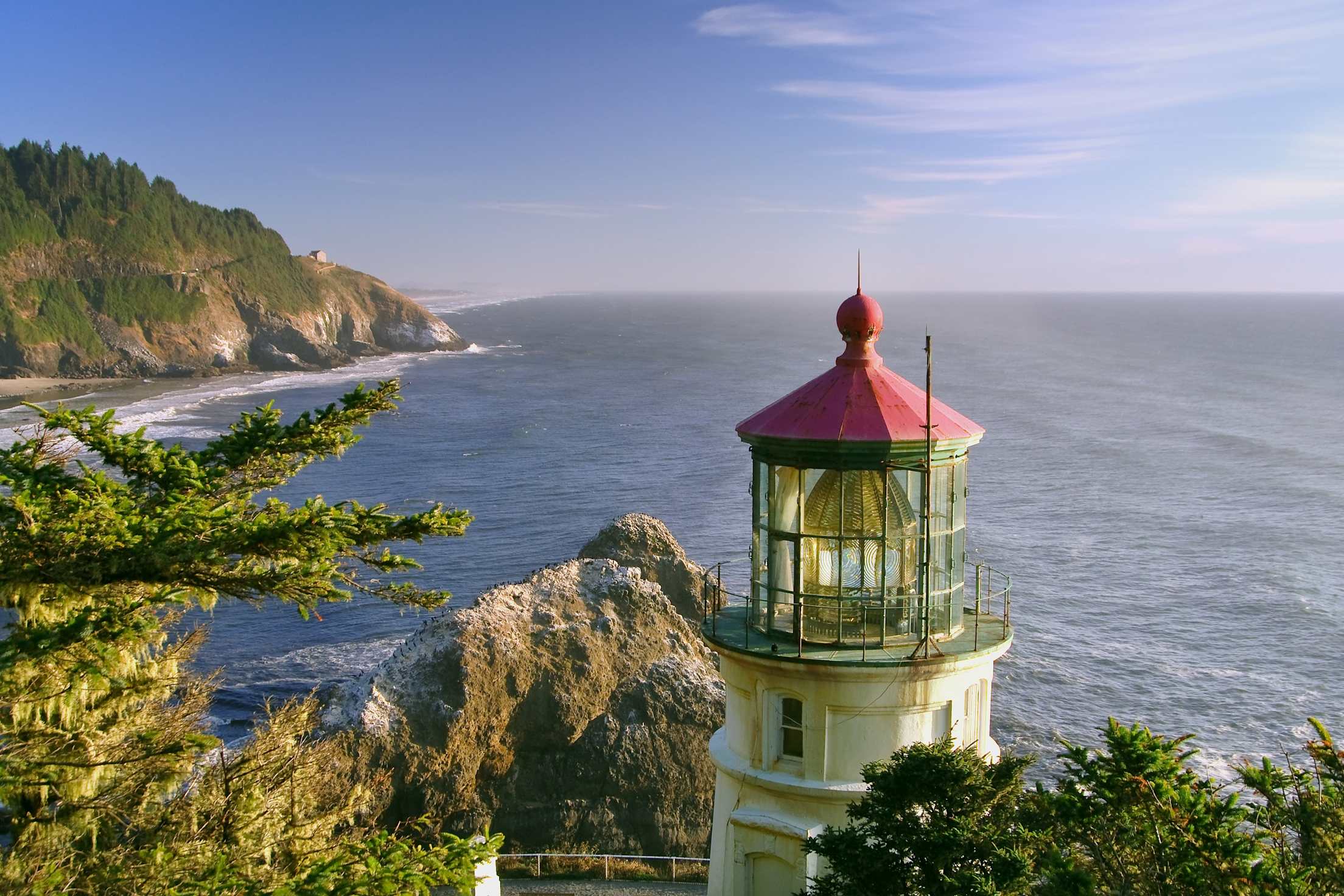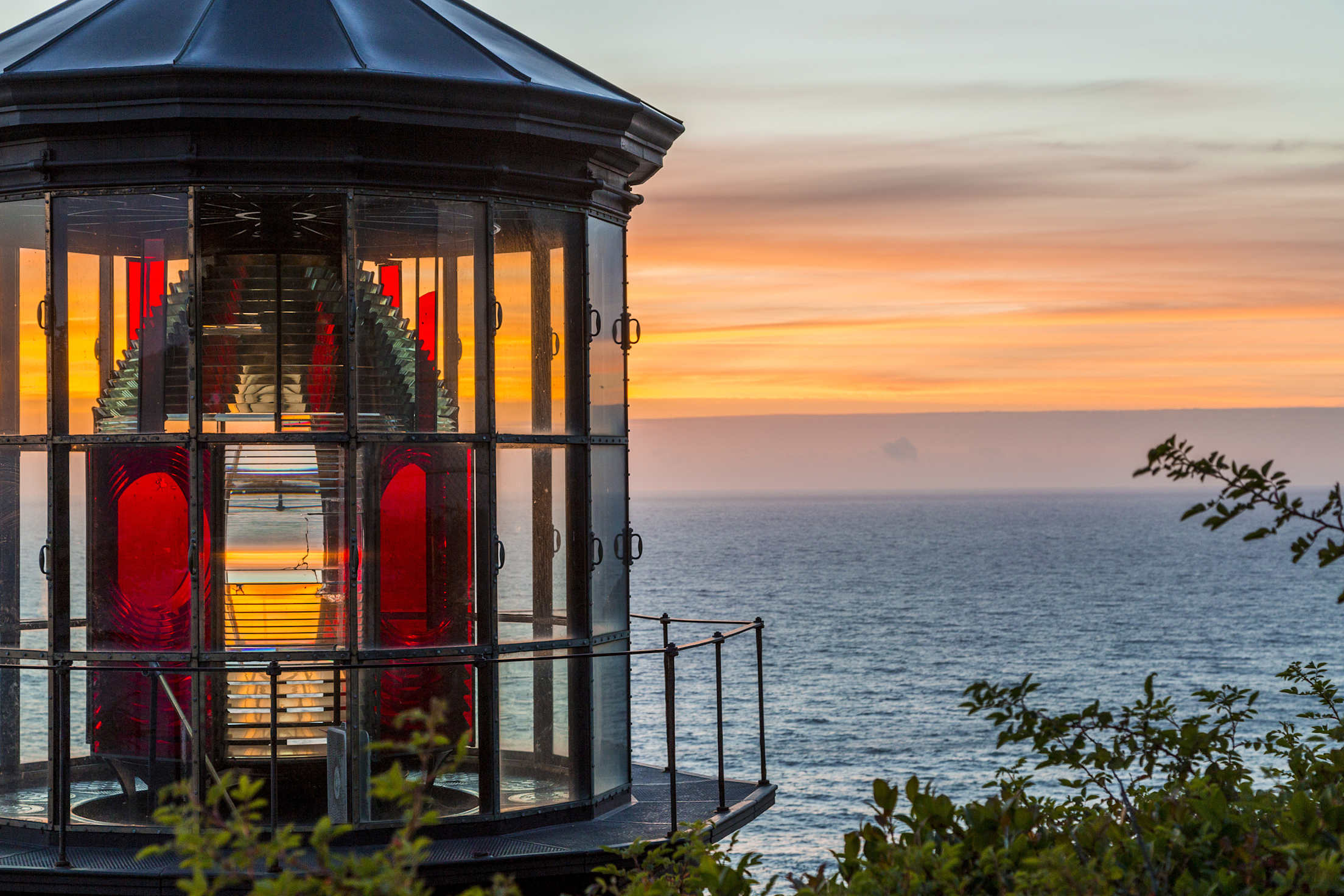
Beautiful Beacons: Best West Coast Lighthouses
From California to Alaska, these 12 towers warn seagoers and welcome landlubbers.

In the beginning, there was no light, just a vast expanse of unilluminated coastline. That changed in the early 1850s, when Congress voted to fund construction of the first eight lighthouses on the West Coast. By the early 1900s, at least 70 watched over the waters from Southern California to the far reaches of Alaska. Flashing both signs of warning and beams of welcome, they enabled the safer navigation vital to the settlement of the West.
Their signals drew strength from an artistic optical advance. The lighthouse lens developed in 1820 by French physicist Augustin-Jean Fresnel resembled a classic beehive and used a series of glass rings to cast a concentrated beam far out to sea. The "Fresnel" (pronounced fray-NEL) came in seven orders, the largest of which (first order) was the gold standard.
Today, even as modern advances have made some lighthouses obsolete, they remain powerful symbols of vigilance, safety, and rescue. "They have a romantic hold on us, not just for what they do but for what they stand for," says Jeff Gales, executive director of the United States Lighthouse Society, a preservation group.
Then, of course, there's their looks. Many stand against some of the world's most stunning backdrops—lovely sights to behold, even if you're not lost at sea.
Point Bonita: Off Highway 1, in California's Marin Headlands
Its slender wooden footbridge provides the only access route to the Point Bonita tower, which sits precariously on a narrow ledge overlooking the Golden Gate, the mouth of San Francisco Bay.
A longtime hazard to mariners, these unforgiving cliffs also presented perils to early lighthouse keepers. Consider Alexander Martin, who moved here in the early 1900s. His children were strapped into rope harnesses when they played outside, a precautionary step that saved the life of Martin's son, once found dangling over the ledge.

The Fresnel lens at the Haceta Lighthouse still glows on the water.
Heceta Head: Off Highway 101, halfway between Florence and Yachats, Oregon
The arresting scene seems sprung from a storybook: a bright white sentinel capped with a red roof, set on a spruce-carpeted bluff. The brightest lighthouse on the Oregon coast, Heceta Head also ranks as one of the most beautiful in the world. And building it cost a pretty penny. Materials had to be hauled in by horse or boat, then brought up steep trails on 200-foot cliffs.
By the time it was completed in 1894, the 56-foot tower had cost $80,000, a princely figure for the era. Fortunately, few expenses have been spared in its preservation. The Queen Anne–style keeper's house is now a bed-and-breakfast, a nearby oil house holds an interpretive center, and the first-order Fresnel lens still shines over the sea.
Pigeon Point: Off Highway 1, 20 miles south of Half Moon Bay, California
This picturesque lighthouse cast its first beam in 1872—too late to help the Carrier Pigeon, a cargo ship that came to grief here in 1853 and gave the windswept promontory its name. On that fateful day, fog blanketed the coastline and waves beat hard against the bluffs as the captain and his crew scrambled to safety, leaving their ruined vessel on the rocks. At least three other ships sank along the same point before the lighthouse was completed.
Today, though structural problems make the tower off-limits to the public, the keepers' bungalows have been transformed into a youth hostel and the grounds are open for informal tours every day at 1 p.m.
Point Cabrillo: Off Highway 1, in Mendocino, California
Here's a tale of role reversal: The Point Cabrillo Light Station, created to save lives, was itself rescued in recent years. The 1909 beacon languished in disrepair—its roof missing shingles and its paint peeling badly inside and out. Developers had even hatched plans to build homes on surrounding land. Then the California Coastal Conservancy and a group of lighthouse lovers stepped in to restore the facility and create a nature reserve around it. The 300-acre property became a state park in 2002. Point Cabrillo now stands as a preservation success story, complete with a museum and cottages for overnight rental.
Point Reyes: Point Reyes National Seashore, California
Standing at what feels like the edge of the earth, on a cliff battered by winds and besieged by fog, this cast-iron lighthouse proved a daunting outpost from the day it opened in 1870. The extremes of the weather (keepers once recorded 176 consecutive hours of fog), coupled with the perils of the location, drove some who manned it to bouts of "insanity, alcoholism, violence, and insubordination," according to a publication of the National Park Service. That includes the keeper who took to downing alcohol he should have been using to clean the lens.
Despite these strains, most did heroic jobs. When the 1906 earthquake dislodged the 6,000-pound lens, keepers restored it to service in time for its nightly duties.
Visitors can brave their own challenge: hiking down (and then back up) the 308 stairs to the lighthouse. On clear days in the winter and spring, the point provides an ideal lookout from which to watch for migrating gray whales.
Cape Disappointment: Off Highway 101, three miles south of Ilwaco, Washington
Near the southern tip of Washington, the Columbia River spouts sediment into the ocean, shaping the ever shifting sandbars that make these waters some of the most dangerous in the world—the "Graveyard of the Pacific," sailors like to say.
As early as 1846, the U.S. government wanted to build a lighthouse here. The project was delayed, aptly enough, when a cargo ship delivering construction materials foundered off the coast, and the tower wasn't finished until 1856.
What stands today at Cape Disappointment is a 53-foot concrete structure, painted white with a black band to distinguish it from nearby North Head lighthouse. The keeper's quarters are gone, but the now-automated lighthouse still stands watch over the rough currents. Even with the beacon in place, the waters have claimed some 2,000 vessels to date.
Point Arena: Off Highway 1, in Point Arena, California
The 1992 film Forever Young features Mel Gibson playing a man who emerges from cryogenic storage. The lighthouse plays itself, appearing in the background while the protagonist, Daniel McCormick, flies a small plane along the coast. It's a fitting cameo, since the lighthouse, like McCormick, has been lovingly preserved.
The original 1870 sentinel had to be entirely replaced after suffering damage in the 1906 earthquake. A smokestack-builder did the job, creating the first lighthouse in the country to be fashioned from reinforced concrete. Restorations replaced the roof and converted the lantern room into an observation deck. Visitors can climb to the top of the 115-foot outpost or stop at the ground-level museum, where the original Fresnel lens glitters on display.
Yaquina Head: Off Highway 101, in Newport, Oregon
A scenic promontory makes a stunning backdrop for this 93-foot beacon, the tallest in the state since its construction in 1873. Though the keeper's house has been demolished, the conical brick lighthouse is in excellent condition, equipped with a remarkable nine-foot Fresnel lens. It flashes its distinctive pattern—two seconds on, two off, two on, 14 seconds off—at all hours of the day. Another traveler's note: the lighthouse is located in the Yaquina Head Outstanding Natural Area, with paved trails and wooden steps leading to tide pools.
Sentinel Island: Sentinel Island, 25 miles northwest of Juneau, Alaska
The Alaskan gold rush made the perils of the sea readily apparent. In 1898 when the Klondike stampede was at its height, some 23 ships wrecked in the waters of southeast Alaska, including the treacherous Inside Passage route between the mainland and the coastal island cluster where this light stands.
First illuminated in 1902, the original wooden lighthouse was replaced in 1935 by the existing concrete structure, an elegant example of art deco design. Lighthouses in Alaska are famously remote, and this beacon is one of the few that can be seen from the state's mainland. Visits and overnight stays can be arranged by advance reservation. Call the Gastineau Channel Historical Society at (907) 586-5338.
Cape Hinchinbrook: Prince William Sound, Alaska
Long before the Exxon Valdez tanker spilled 10 million gallons of oil in Prince William Sound, these waters were known for their danger. To reduce the risk, a lighthouse was first placed here in 1910, so solidly built that some called it indestructible. The label stuck until the late 1920s when the structure was undone by back-to-back earthquakes. Engineers erected a new lighthouse in 1934, a showpiece of moderne art design. It's not open to the public but can be seen by cruise ships and ferries traveling in and out of the sound.

Don't be fooled by this lighthouse's modest stature.
Cape Meares: Cape Meares State Scenic Viewpoint, 10 miles northwest of Tillamook, Oregon
Just 38 feet tall, Oregon's shortest lighthouse sits atop a 200-foot bluff. Any taller and its signal could have been lost in fog. The unimposing structure worked fine until 1963, when the lighthouse was decommissioned and its function replaced by something even shorter—a concrete blockhouse with an automated signal. The new system lacks the romance of the original, which relied on an eight-sided lens equipped with four red panes known as bull's-eyes to produce a steady white beam interrupted every 30 seconds by a red flash.
Cape Blanco: Off Highway 101, nine miles north of Port Orford, Oregon
Stark white cliffs rising 200 feet above the water caught the attention of early Spanish sailors, who named the location Cabo Blanco and probably used the chalky silhouettes as nautical signposts. The beacon constructed in 1870 was an even better guide and became a landmark of superlatives: Oregon's oldest, highest (at 245 feet above sea level), and westernmost lighthouse. It was also the workplace of the state's first female lighthouse keeper, Mabel Bretherton, a widowed mother of three who took up the post in 1903.